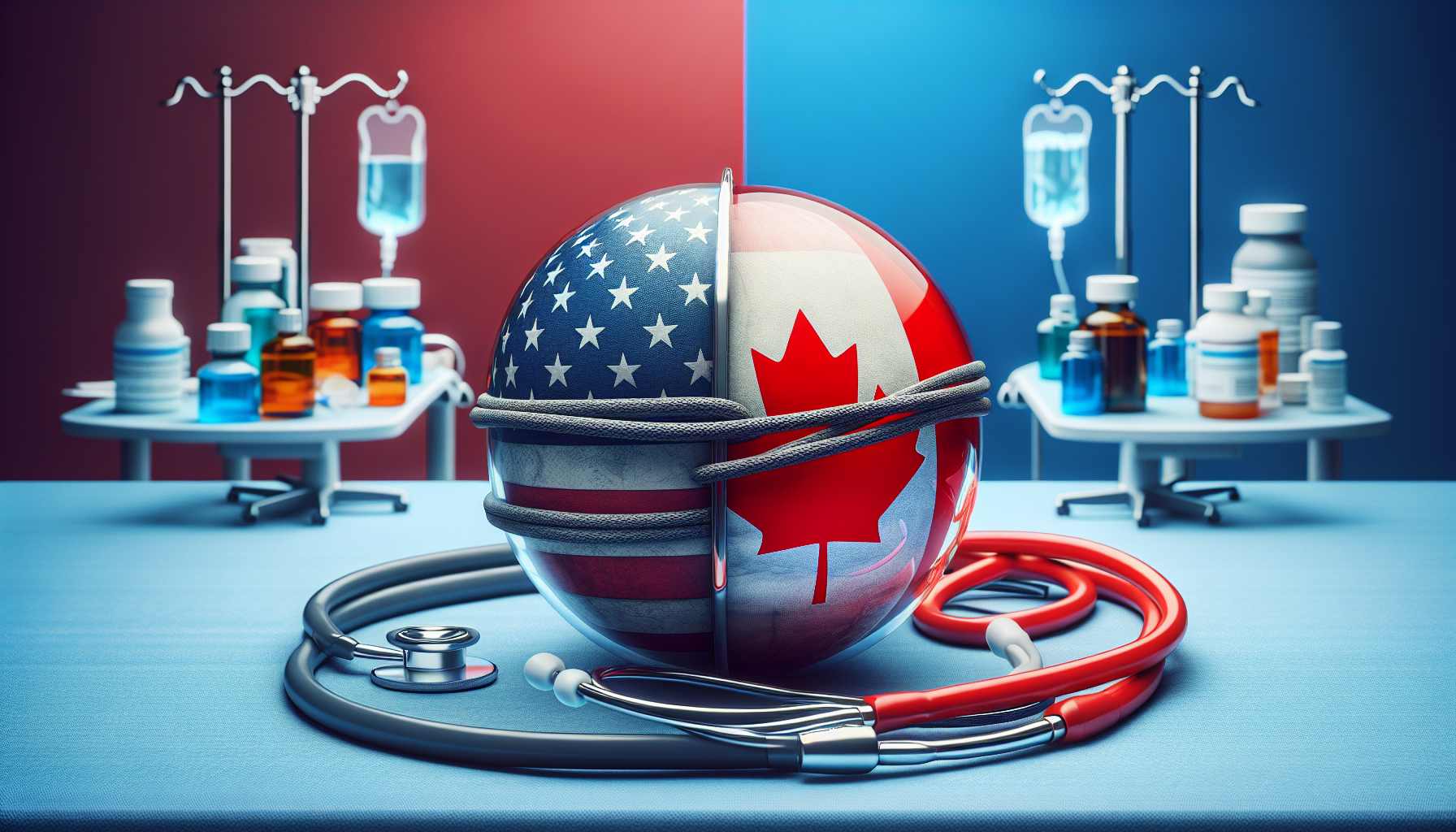Have you ever wondered how healthcare systems in the United States and Canada stack up against each other? In this article, we’ll explore the key differences between these two countries when it comes to healthcare. From the way healthcare is funded to the accessibility and cost of services, we’ll take a closer look at what sets them apart. So, grab a cup of coffee and get ready to discover how healthcare in the US compares to Canada’s system.

Cost of Healthcare
Healthcare spending in the US
In the United States, healthcare spending is remarkably high compared to other developed countries. The country spends more than $10,000 per person annually on healthcare, which accounts for a significant portion of their GDP. This high spending can be attributed to several factors, including the high cost of medical services, prescription medications, and advanced medical technology. Additionally, administrative costs, such as insurance processing and billing, also contribute to the overall healthcare spending in the US.
Healthcare spending in Canada
In Canada, healthcare spending is significantly lower compared to the United States. The Canadian government allocates a substantial portion of its budget to healthcare, ensuring that all citizens have access to essential medical services. On average, Canada spends around $5,900 per person annually on healthcare. This lower spending is partly attributed to the country’s universal healthcare system, which aims to provide comprehensive care to all residents.
Factors contributing to cost differences
There are several factors contributing to the cost differences between healthcare in the US and Canada. One significant factor is the difference in healthcare systems. While the US relies heavily on private healthcare providers and insurance companies, Canada has a publicly funded and managed healthcare system. The presence of a profit-driven system in the US often leads to inflated prices for medical services, prescription drugs, and medical technologies.
Additionally, the high cost of prescription drugs is a significant contributor to healthcare expenses in the US. The lack of government regulation and negotiation power in drug pricing allows pharmaceutical companies to set exorbitant prices for essential medications, making them unaffordable for many individuals. In contrast, Canada benefits from a single-payer system, enabling the government to negotiate drug prices, resulting in more affordable access to medications.
Insurance coverage and costs
Insurance coverage plays a vital role in healthcare costs. In the US, the lack of universal healthcare coverage leads to a significant portion of the population being uninsured or underinsured. This results in individuals having to pay substantial out-of-pocket expenses for medical services and prescription drugs. The high cost of private health insurance premiums, deductibles, and copayments further burdens individuals and families.
In Canada, however, healthcare is provided through a single-payer system, known as Medicare. This system ensures that all Canadian residents have access to essential medical services without the need for private insurance. Instead, Canadians contribute to the healthcare system through income taxes. This approach reduces the financial burden on individuals and eliminates the need for expensive private health insurance.
Access to Healthcare
Healthcare system in the US
The healthcare system in the United States is a complex combination of private and public entities. It heavily relies on private insurance companies, employers, and individual payments for healthcare services. While the US has advanced medical technology and a large number of healthcare providers, access to healthcare can be limited for many Americans, especially those who are uninsured or underinsured. The lack of a universal healthcare system means that individuals must navigate a complex web of insurance plans, provider networks, and affordability concerns to receive necessary care.
Healthcare system in Canada
Canada, on the other hand, has a publicly funded and managed healthcare system called Medicare. This system ensures that all Canadians have equal access to essential medical services regardless of their income or employment status. Healthcare services are primarily provided by doctors and hospitals that receive payments from the government. This approach eliminates financial barriers to healthcare and allows Canadians to receive the care they need when they need it.
Primary care availability
In the US, access to primary care can be a challenge, especially for individuals in rural areas and underserved communities. The shortage of primary care physicians and the high cost of healthcare often result in delayed or limited access to primary care services. This can lead to preventable health issues worsening over time, adding to the overall healthcare costs.
In Canada, the primary care availability is generally better due to its emphasis on preventive care and the presence of a larger primary care workforce. Canadians have access to family physicians who serve as their primary point of contact for medical concerns. This approach helps to promote early detection and intervention, ultimately leading to better health outcomes and cost savings.
Specialist care availability
Both the US and Canada face challenges when it comes to access to specialist care. In the US, the high cost of healthcare and the fragmented insurance system can create barriers for individuals to see specialists. Additionally, wait times for specialist appointments can be lengthy, causing unnecessary delays in receiving specialized care.
In Canada, wait times for specialist care can also be a concern. While the country has made efforts to reduce these wait times, some individuals may experience delays in accessing specialized care. However, Canada’s publicly funded healthcare system ensures that individuals will eventually receive the necessary care, regardless of their ability to pay.
Quality of Care
Wait times in the US
In the US, wait times for medical appointments can vary significantly depending on the location, healthcare provider, and the specific medical condition. While some individuals may experience shorter wait times, others may face delays in receiving necessary care. This variability in wait times can be attributed to the complexity of the US healthcare system and the challenges of coordinating care across different providers and insurance plans.
Wait times in Canada
Similarly, wait times for medical appointments in Canada can also vary, but generally, Canadians experience shorter wait times compared to their American counterparts. The Canadian government has implemented strategies to reduce wait times, such as increasing the number of healthcare professionals and investing in new healthcare facilities. However, some individuals may still face longer waits for non-emergency procedures or specialized care.
Healthcare outcomes in the US
Despite high healthcare spending, the US lags behind many other developed countries in terms of healthcare outcomes. The country has higher rates of chronic diseases, lower life expectancy, and higher infant mortality rates compared to countries with universal healthcare systems. These outcomes can be attributed to various factors, including limited access to primary care, health disparities, and the high cost of medical services, which often lead to delayed or inadequate treatment.
Healthcare outcomes in Canada
Canada generally performs better than the US in terms of healthcare outcomes. The country has lower rates of chronic diseases, higher life expectancy, and lower infant mortality rates. The emphasis on primary care, early intervention, and preventive services contribute to these positive outcomes. The publicly funded healthcare system in Canada ensures that individuals receive necessary care without financial barriers, ultimately leading to better health outcomes.
Patient Satisfaction
Patient satisfaction in the US
Patient satisfaction in the US healthcare system can vary depending on individuals’ experiences and access to care. While some Americans report positive experiences with their healthcare providers, others may encounter challenges navigating the complex healthcare system or face barriers to affordable care. The high out-of-pocket costs, insurance complexities, and lack of continuity of care can impact patient satisfaction levels.
Patient satisfaction in Canada
Overall, Canadians tend to have higher levels of satisfaction with their healthcare system compared to Americans. The presence of a publicly funded system that provides universal coverage contributes to this satisfaction. Canadians appreciate the accessibility of healthcare services without financial burden and value the comprehensive care they receive. However, like any healthcare system, there are areas for improvement, including reducing wait times and addressing regional disparities.
Factors affecting patient satisfaction
Several factors influence patient satisfaction in both the US and Canada. Communication and interpersonal skills of healthcare providers play a significant role in patient satisfaction. Patients value providers who listen to their concerns, involve them in decision-making, and demonstrate empathy and respect. Additionally, factors such as wait times, access to appointments, and affordability of medications and treatments can impact patient satisfaction.
Healthcare provider interactions
Positive healthcare provider interactions are vital to patient satisfaction. In both the US and Canada, healthcare providers play a crucial role in delivering care and cultivating trusting relationships with their patients. Providers who communicate effectively, demonstrate empathy, and involve patients in shared decision-making contribute to higher levels of patient satisfaction. These interactions help build a collaborative approach to healthcare and foster a positive patient experience.

Healthcare Reforms
Healthcare reforms in the US
The US has seen several healthcare reforms aimed at addressing the challenges of high costs, limited access, and disparities in care. The Affordable Care Act (ACA), enacted in 2010, aimed to expand health insurance coverage and improve access to care for millions of Americans. While the ACA made significant strides in reducing the uninsured rate, challenges remain in achieving universal coverage and reducing overall healthcare costs.
Healthcare reforms in Canada
Canada has a long history of healthcare reforms aimed at improving access, efficiency, and quality of care. These reforms focus on reducing wait times, increasing healthcare funding, expanding primary care services, and investing in healthcare infrastructure. The Canadian government continues to work towards improving the healthcare system based on feedback from residents, healthcare providers, and ongoing assessments of healthcare outcomes.
Comparison of healthcare systems
When comparing the healthcare systems of the US and Canada, it becomes evident that they have distinct approaches to healthcare delivery and financing. The US relies heavily on a mix of private and public components, with a focus on individual insurance coverage. In contrast, Canada employs a publicly funded and managed system that prioritizes universal coverage and equitable access to care.
The US system offers a greater choice of providers and more advanced medical technologies, but many individuals face challenges accessing affordable care, resulting in disparities in health outcomes. On the other hand, the Canadian system prioritizes accessibility and provides comprehensive care to all residents, but may face challenges in terms of wait times for certain procedures and specialized care.
Efforts to address issues
Both the US and Canada recognize the need for ongoing efforts to address the challenges within their healthcare systems. In the US, discussions around universal healthcare coverage, reducing prescription drug costs, and improving healthcare affordability and accessibility are ongoing. Various proposals have been put forward, with the aim of expanding coverage and addressing the root causes of high healthcare costs.
In Canada, efforts are focused on reducing wait times, enhancing primary care services, and addressing regional disparities. The Canadian government works closely with healthcare providers, stakeholders, and the public to identify areas for improvement and implement strategies to enhance the delivery of healthcare services.
Pharmaceuticals
Cost of prescription drugs in the US
The cost of prescription drugs in the US is significantly higher compared to other countries. The absence of government regulation and negotiation power allows pharmaceutical companies to set high prices for medications. The complex web of insurance plans and pharmacy benefit managers further contribute to the high out-of-pocket costs for individuals. The high cost of prescription drugs places a burden on patients, particularly those with chronic conditions who rely on long-term medication use.
Cost of prescription drugs in Canada
In Canada, prescription drugs are generally more affordable compared to the US. The government negotiates drug prices with pharmaceutical manufacturers on behalf of its citizens, resulting in lower costs. Additionally, the presence of a single-payer system allows for bulk purchasing, further driving down medication prices. Canadians benefit from this system, as it ensures access to necessary medications without excessive financial burden.
Purchasing and regulation of drugs
The US and Canada have different approaches to the purchasing and regulation of drugs. In the US, pharmaceutical manufacturers negotiate drug prices with various entities, including insurance companies and pharmacy benefit managers, resulting in varying prices for the same medications. The US Food and Drug Administration (FDA) regulates the approval and safety of drugs in the country.
In Canada, the government negotiates drug prices directly with pharmaceutical manufacturers, ensuring consistent pricing across the country. The regulation of drugs is overseen by Health Canada, which also monitors the safety and efficacy of medications.
Availability and coverage
In the US, the availability and coverage of prescription drugs can vary depending on insurance plans and formularies. Some individuals may face barriers in accessing certain medications due to high costs or insurance restrictions, while others may have more comprehensive coverage. The lack of universal coverage in the US results in varying levels of medication access and affordability.
In Canada, the publicly funded healthcare system includes coverage for necessary prescription drugs, ensuring that Canadians have access to essential medications without financial barriers. While there may be certain limitations and restrictions based on clinical guidelines, the overall availability and coverage of prescription drugs in Canada are higher compared to the US.

Medical Technology
Availability of advanced medical technology in the US
The US is known for its advancements in medical technology and innovation. The country invests heavily in research and development, leading to the availability of state-of-the-art medical technology. This includes advanced imaging systems, robotic surgical systems, and breakthrough treatments that contribute to improved patient outcomes. However, the high cost of acquiring and utilizing these technologies can sometimes limit access, particularly for individuals without adequate insurance coverage.
Availability of advanced medical technology in Canada
While Canada may not have the same level of investment and access to cutting-edge medical technology as the US, it still boasts a high standard of care. Canada prioritizes the use of cost-effective medical technologies that demonstrate significant clinical benefit. The country has access to essential medical equipment and advanced treatments, although there can be variability in availability across different regions.
Impact on healthcare outcomes
The availability of advanced medical technology can have a significant impact on healthcare outcomes. Both the US and Canada benefit from access to advanced technologies that help diagnose and treat various medical conditions. These technologies enable healthcare providers to offer more accurate diagnoses, perform less invasive procedures, and deliver targeted therapies. Ultimately, the use of advanced medical technology contributes to improved patient outcomes and quality of care.
Affordability and accessibility
While the US has a greater availability of advanced medical technology, the cost of these technologies can pose challenges for individuals without adequate insurance coverage. The high price tags associated with acquiring and maintaining advanced equipment can result in higher overall healthcare costs. In Canada, the focus is on providing cost-effective technologies that offer a balance between clinical benefit and affordability. While the availability may differ from the US, Canada strives to ensure accessibility to essential medical technologies for its residents.
Healthcare Workforce
Number of healthcare professionals in the US
The United States has a large number of healthcare professionals, including physicians, nurses, pharmacists, and other allied healthcare workers. The country attracts healthcare professionals from around the world due to its advanced medical education and training programs. However, there can be significant variation in the distribution of healthcare professionals, leading to disparities in access to care, particularly in rural and underserved areas.
Number of healthcare professionals in Canada
Canada also has a substantial healthcare workforce, including doctors, nurses, and allied healthcare professionals. The country prioritizes the training and education of healthcare professionals to ensure a sufficient supply to meet the needs of its population. However, similar to the US, there can be regional disparities in the distribution of healthcare professionals, leading to challenges in accessing care in remote and rural areas.
Training and education
Both the US and Canada prioritize the training and education of healthcare professionals. Medical schools and nursing programs in both countries provide comprehensive education and training to produce competent healthcare providers. Continuing education and professional development opportunities are also widely available to ensure that healthcare professionals stay up-to-date with the latest advancements in medical practice.
Workforce distribution
The distribution of healthcare professionals is a challenge faced by both the US and Canada. In the US, certain regions, particularly rural and underserved areas, struggle to attract and retain healthcare professionals, leading to limited access to care. In Canada, geographic barriers and regional disparities can also result in uneven distribution, making it more difficult for some individuals to access healthcare services. Efforts are being made in both countries to address these workforce distribution challenges and improve access to care for all residents.

Government Involvement
Role of government in US healthcare
In the United States, the government plays a complex role in healthcare. While the US does not have a universal healthcare system, the government is involved in various aspects of healthcare, including Medicare and Medicaid programs for specific populations, regulation of pharmaceuticals through the FDA, and funding for medical research through agencies like the National Institutes of Health (NIH). The government also provides healthcare coverage for military personnel and veterans through the Department of Defense and the Department of Veterans Affairs.
Role of government in Canadian healthcare
In Canada, the government plays a more direct role in healthcare. The publicly funded healthcare system, also known as Medicare, is primarily financed and managed by the provincial and territorial governments. This system ensures that all residents have access to medically necessary services, regardless of their ability to pay. The government also regulates the healthcare providers, establishes policies, and negotiates drug prices on behalf of Canadians.
Public vs private healthcare
The US and Canada have differing approaches when it comes to the balance between public and private healthcare. In the US, the system relies heavily on private healthcare providers and insurance companies. Individuals have the freedom to choose their healthcare providers, insurance plans, and treatment options. Private healthcare in the US allows for a greater variety of services and specialized care, but it can also lead to higher costs and disparities in access.
In Canada, the focus is on public healthcare, ensuring that essential medical services are provided to all residents on an equitable basis. Private healthcare services may exist in Canada, but the country’s healthcare system is primarily publicly funded and managed. This approach aims to prioritize accessibility and reduce financial barriers to care. While private healthcare options may provide certain advantages, the majority of Canadians rely on the publicly funded system for their healthcare needs.
Government funding and regulations
Government funding and regulations significantly impact healthcare in both the US and Canada. In the US, government funding primarily supports specific populations and programs, such as Medicare and Medicaid. The government also regulates the healthcare industry, including insurance providers and pharmaceutical companies, ensuring compliance with standards and safety regulations.
In Canada, the government provides the majority of funding for the healthcare system. This public funding is derived from tax revenues and is used to provide essential medical services to all residents. The government also regulates the healthcare system, ensuring quality of care, setting standards, and negotiating drug prices to control costs.
Challenges and Future Directions
Challenges faced by the US healthcare system
The US healthcare system faces several challenges that impact the accessibility, affordability, and quality of care. The absence of universal coverage leaves many individuals without access to essential medical services. The high cost of healthcare, including medical services and prescription drugs, burdens individuals and contributes to disparities in access to care. The fragmentation of the system, with multiple insurance plans and providers, adds complexity and administrative costs. Addressing these challenges will require comprehensive healthcare reforms that prioritize universal coverage, cost containment, and improved access.
Challenges faced by the Canadian healthcare system
While Canada’s healthcare system is often lauded for its accessibility, challenges still exist. Wait times for certain procedures and specialized care can be a significant concern, resulting in delays for individuals seeking treatment. Regional disparities in access to healthcare, particularly in remote and rural areas, pose challenges for some Canadians. Additionally, the cost of healthcare and the sustainability of the publicly funded system are ongoing concerns. Continued efforts to address these challenges, such as reducing wait times and investing in healthcare infrastructure, are necessary to ensure the ongoing success of the Canadian healthcare system.
Potential improvements
Both the US and Canada can benefit from potential improvements in their healthcare systems. In the US, expanding access to affordable healthcare coverage through universal healthcare reforms would address the issue of uninsured and underinsured individuals. Implementing measures to reduce the cost of prescription drugs and increasing transparency in healthcare pricing can also improve affordability. Emphasizing preventive care, primary care, and care coordination can help improve health outcomes and reduce overall costs.
In Canada, efforts to reduce wait times for specialized care, particularly in certain regions, can help address access barriers. Investing in healthcare infrastructure, including medical facilities and technology, can further improve access and ensure that Canadians receive the best possible care. Continued collaboration between the government, healthcare providers, and the public is essential to identify and implement effective improvements in the Canadian healthcare system.
Lessons from other countries
Looking to other countries with successful healthcare systems can provide valuable lessons for both the US and Canada. Countries such as Germany and the Netherlands have achieved a balance between public and private elements in their healthcare systems. Their models prioritize universal coverage, choice, and affordability, while also maintaining high standards of care. Lessons can be learned from these countries in terms of healthcare financing, regulation, and care coordination to improve the overall quality and accessibility of healthcare in the US and Canada.
In conclusion, the healthcare systems in the US and Canada have significant differences in terms of cost, access, quality, and patient satisfaction. While the US spends significantly more on healthcare, it faces challenges of high costs, limited access, and disparities in care. Canada, on the other hand, benefits from a publicly funded system that aims to provide comprehensive care to all residents, although it faces challenges of wait times and regional disparities. Both countries have ongoing efforts to address these challenges, with potential improvements and lessons from other countries providing valuable insights for the future direction of healthcare delivery.


